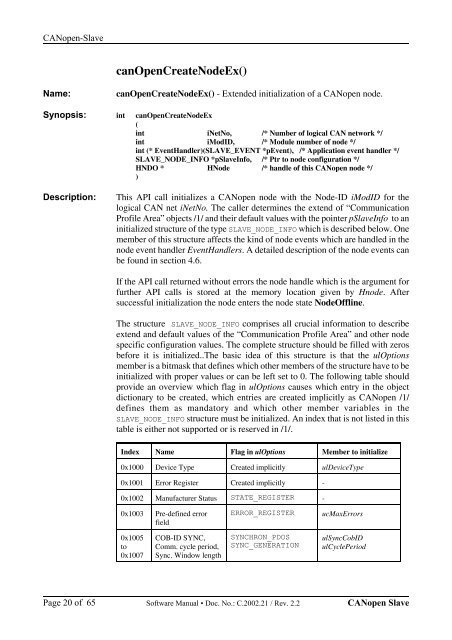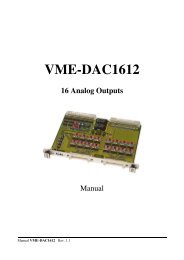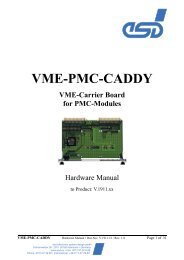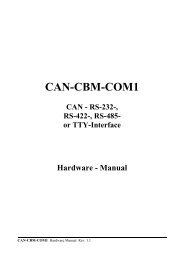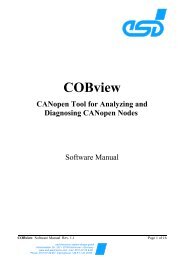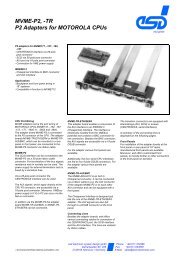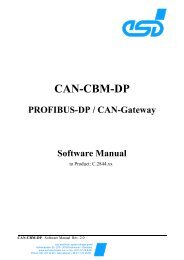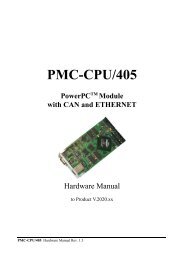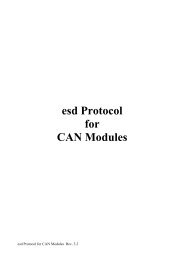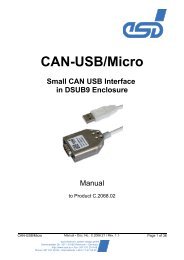CANopen Manager / Slave Manual - esd electronics, Inc.
CANopen Manager / Slave Manual - esd electronics, Inc.
CANopen Manager / Slave Manual - esd electronics, Inc.
You also want an ePaper? Increase the reach of your titles
YUMPU automatically turns print PDFs into web optimized ePapers that Google loves.
<strong>CANopen</strong>-<strong>Slave</strong><br />
Page 20 of 65<br />
canOpenCreateNodeEx()<br />
Name: canOpenCreateNodeEx() - Extended initialization of a <strong>CANopen</strong> node.<br />
Synopsis: int canOpenCreateNodeEx<br />
(<br />
int iNetNo, /* Number of logical CAN network */<br />
int iModID, /* Module number of node */<br />
int (* EventHandler)(SLAVE_EVENT *pEvent), /* Application event handler */<br />
SLAVE_NODE_INFO *p<strong>Slave</strong>Info, /* Ptr to node configuration */<br />
HNDO * HNode /* handle of this <strong>CANopen</strong> node */<br />
)<br />
Description: This API call initializes a <strong>CANopen</strong> node with the Node-ID iModID for the<br />
logical CAN net iNetNo. The caller determines the extend of “Communication<br />
Profile Area” objects /1/ and their default values with the pointer p<strong>Slave</strong>Info to an<br />
initialized structure of the type SLAVE_NODE_INFO which is described below. One<br />
member of this structure affects the kind of node events which are handled in the<br />
node event handler EventHandlers. A detailed description of the node events can<br />
be found in section 4.6.<br />
If the API call returned without errors the node handle which is the argument for<br />
further API calls is stored at the memory location given by Hnode. After<br />
successful initialization the node enters the node state NodeOffline.<br />
The structure SLAVE_NODE_INFO comprises all crucial information to describe<br />
extend and default values of the “Communication Profile Area” and other node<br />
specific configuration values. The complete structure should be filled with zeros<br />
before it is initialized..The basic idea of this structure is that the ulOptions<br />
member is a bitmask that defines which other members of the structure have to be<br />
initialized with proper values or can be left set to 0. The following table should<br />
provide an overview which flag in ulOptions causes which entry in the object<br />
dictionary to be created, which entries are created implicitly as <strong>CANopen</strong> /1/<br />
defines them as mandatory and which other member variables in the<br />
SLAVE_NODE_INFO structure must be initialized. An index that is not listed in this<br />
table is either not supported or is reserved in /1/.<br />
Index Name Flag in ulOptions Member to initialize<br />
0x1000 Device Type Created implicitly ulDeviceType<br />
0x1001 Error Register Created implicitly -<br />
0x1002 Manufacturer Status STATE_REGISTER -<br />
0x1003 Pre-defined error<br />
field<br />
0x1005<br />
to<br />
0x1007<br />
COB-ID SYNC,<br />
Comm. cycle period,<br />
Sync. Window length<br />
ERROR_REGISTER ucMaxErrors<br />
SYNCHRON_PDOS<br />
SYNC_GENERATION<br />
ulSyncCobID<br />
ulCyclePeriod<br />
Software <strong>Manual</strong> • Doc. No.: C.2002.21 / Rev. 2.2 <strong>CANopen</strong> <strong>Slave</strong>


